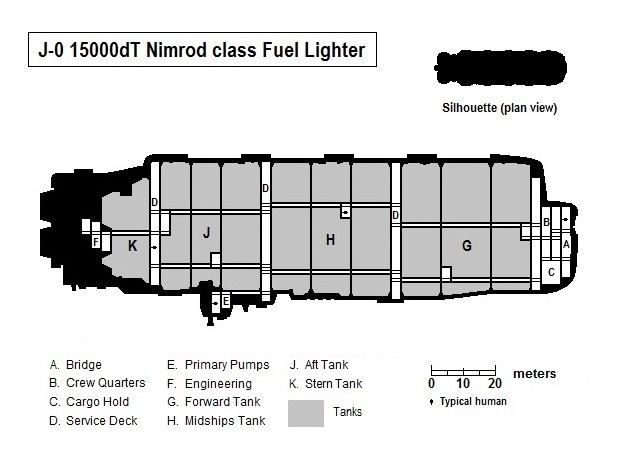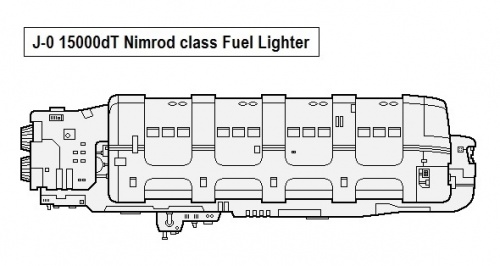Nimrod class Fuel Lighter
| Nimrod class Fuel Lighter | |
|---|---|
 Distant Fringe vessel. | |
| Type: TF Tanker | |
| Category | [[BCS]] |
| Size | 15,000 Tons |
| Hull Configuration | [[Cylinder Hull]] |
| Streamlining | Partially Streamlined Hull |
| Tech Level | TL–10 |
| Engineering | |
| Computer | Model/4 |
| Jump | J-0 |
| Maneuver | 2 G |
| Armaments | |
| Hardpoints | 150 |
| Accommodations | |
| Staterooms | 0 |
| Personnel | |
| Crew | 83 |
| Officers | 17 |
| Enlisted | 66 |
| High/Mid Passengers | 0 |
| Payload | |
| Cargo | 200,0 Tons Fuel Tanks 11,700 Tons |
| Fuel tank | 0 Tons |
| Construction | |
| Origin | Distant Fringe |
| Price | |
| Cost | MCr5,001.570 (base) MCr4,001.256 (qty) |
| Architect fee | MCrAde Stewart |
| Statistics | |
| Quick Ship Profile | Not applicable |
| Images | |
| Blueprint | Yes |
| Illustration | Yes |
| Source | |
| Also see | Tanker |
| Canon | Published, fan design |
| Era | 1105 |
| Reference | Ade Stewart |
| Starships are designed with the Classic Traveller format, using High Guard. | |
The Nimrod class Fuel Lighter is a mercantile bigcraft.
- It is a civilian ship and a Tanker.
- This is a generic class of civilian vessel.
- Please also see AAB article: Ships of the Distant Fringe.
- Please also see AAB article: Warships of the Distant Fringe.
Description (Specifications)
The Fuel Lighter is a non-jump Tanker encountered within the Distant Fringe region and is classified as a Bulk Cargo Carrier. It is designed to operate within a single star system, skimming fuel from gas giant worlds and ferrying it back to the mainworld's Starport facilities or transferring it directly to waiting vessels. Similar designs have been in use from the time the Distant Fringe was first settled.
- The vessel is a TL-10 design.
Image Repository
General Description
The Nimrod class is a partially streamlined cylinder with a mean diameter of 40 meters and a length of around 160 meters. Some sections are narrower and some are wider, giving it a total enclosed volume of approximately 202,500 cubic meters. Huge fuel tanks form the majority of the interior of the ship. The main tanks are subdivided into smaller interlinked cells containing baffles, compressors, and pumping equipment, and are separated by service decks. The engineering section is located aft, within the core of the vessel, while the bridge and accessible sections of the vessel such as the crew quarters and the cargo hold are located forward. Transfer shafts, offset from one another to reduce the risks associated with accidents or damage, link the various decks together.

A basic deck plan of the vessel indicating the general layout and positioning of major elements.
Basic Ship Characteristics
Following the Imperial Navy and IISS Universal Ship Profile and data, additional information is presented in the format shown here. The small craft factor indicates the number of squadrons (...of ten subcraft) carried on the ship. Tonnage on the universal ship profile is shown in kilotons (...thousands of tons) where necessary. [1]
| Basic Ship Characteristics [2] | ||
|---|---|---|
| No. | Category | Remarks |
| 1. | Tonnage / Hull | The Fuel Lighter is constructed using a 15,000 dTon hull built in a cylindrical configuration. The hull is partially streamlined and has a limited capability to perform atmospheric operations: its atmospheric handling characteristics are entirely reliant on its onboard gravitic systems.
|
| 2. | Crew | Total Crew Complement: 83
Accommodations
Accessible areas of the hull are fitted with grav plates and inertial compensators and have full life support and environmental systems.
|
| 3. | Performance | The vessel mounts a Maneuver-2 drive and a Power Plant-2, giving performance of 2-G acceleration and producing 300 Energy Points. The ship has an agility rating of 1 and an emergency agility of 2. The dedicated internal fuel tankage gives the power plant 4 weeks duration.
|
| 4. | Electronics | Adjacent to the bridge is a Model/4 Computer: the vessel has a backup Model/4 Computer.
|
| 5. | Hardpoints | x150 hardpoints.
|
| 6. | Armament | The Fuel Lighter is generally unarmed. |
| 7. | Defenses | The hull is unarmored.
x80 triple Sandcaster turrets, grouped into eight batteries each of 10 linked turrets The vessel is not fitted with screens or other passive defensive systems. |
| 8. | Craft | Flight Section
The lifeboat is housed in a dedicated hangar located in the bow of the vessel, close to the accommodations: the hangar can be sealed and has a total volume of 65 dTons. |
| 9. | Fuel Treatment | The vessel has dedicated internal fuel tankage of 300 dTons.
The vessel has commercial fuel tankage of 11,700 dTons.
|
| 10. | Cost | The basic cost of the vessel, complete with its complement of subcraft, is MCr5,001.570 |
| 11. | Construction Time | 166 weeks (42 months) as standard.
|
| 12. | Comments | Standard cargo capacity amounts to 200 dTons.
|
History & Background (Dossier)
The design is representative and a large number of variants exist, particularly with regard to the allotted weapons systems, onboard electronics, and the fit out of internal spaces. Fuel Lighters are designed to work within a single system, skimming fuel from gas giant worlds and transporting it back to the local starport, using its onboard refining plant to process and purify the product en route. Examples of the Nimrod class are rarely seen in systems lacking gas giants.
Nimrods are Gas Traders. They may work with orbital port facilities such as the Harbor class Station.
Nimrods and similar vessels are generally regarded as "hell ships", capable of generating immense profits for their owners and driven extremely hard by their captains and masters to do as many skimming runs as possible. In busy ports, with a constant demand for fuel, Nimrods fight to shave minutes off of their total turnaround time.
Distant Fringe Vessels
The Distant Fringe is said to be a far spinward-rimward area inhabited by colonists and refugees originating on Terra. The region is extremely isolated, separated from the rest of Charted Space by vast, almost uncrossable rifts that were once broached by a system of calibration Points and the use of tankers. Those few academics within Charted Space who have found references to the Distant Fringe regard it as little more than a tall tale. Likewise, many of the inhabitants of the Distant Fringe believe the existence of Charted Space to be mythical.[3]
Vessels originating within the Distant Fringe are very rarely encountered outside of the region. However, misjumps do occur and anomalies with bizarre spacetime and Jumpspace effects exist: as such, craft of this type are not entirely unknown within Charted Space.[4]
Class Naming Practice/s & Peculiarities
A number of companies manufacture ships equivalent to the Nimrod class. They vary in hull shape and internal layout but all share the same basic design and all have very similar capabilities and performance characteristics.
While fuel lighters are well built and capable vessels, the various classes see hard service and receive relatively low levels of maintenance. They are driven hard by their owners and commanders, exhausting their crews and further increasing the hazards. The engineering decks, in particular, linked by a single transfer shaft and entirely surrounded by fuel tanks, are considered a death-trap.
- Each variant class is named by the company that produces it: these organizations generally draw on traditional naming protocols. It is not uncommon for a historical class name to be reused.
- Individual vessels within a class are issued specific serial numbers and transponder codes but traditionally are named by their owners. This is considered a serious affair and a ship with a frivolous name is considered "unlucky".
Selected Variant Types & Classes
References & Contributors (Sources)
| This article has metadata. |
| This article is missing content for one or more detailed sections. Additional details are required to complete the article. You can help the Traveller Wiki by expanding it. |
- Marc Miller, Frank Chadwick, John Harshman. High Guard (Game Designers Workshop, 1980), 20-37. (Design Sequence Used)
- Traveller Wiki Editorial Team
- Author & Contributor: Tom Chlebus
- Author & Contributor: Lord (Marquis) and Master Scout Emeritus Adie Alegoric Stewart of the IISS
- Author & Contributor: Lord (Marquis) and Master of Sophontology Maksim-Smelchak of the Ministry of Science
- ↑ Timothy B. Brown. Fighting Ships (Game Designers Workshop, 1981), 10.
- ↑ Timothy B. Brown. Fighting Ships (Game Designers Workshop, 1981), 10.
- ↑ Information provided to the library by Maksim-Smelchak
- ↑ Information provided to the library by Maksim-Smelchak
